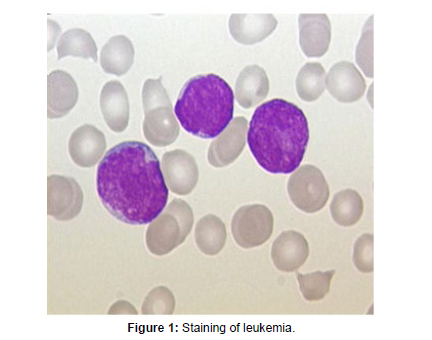Imaging on Treatment and Diagnosis of Pediatric B-Intense Lymphoblastic Leukemia
Received: 06-Jul-2023 / Manuscript No. roa-23-107758 / Editor assigned: 08-Jul-2023 / PreQC No. roa-23-107758 (PQ) / Reviewed: 22-Jul-2023 / QC No. roa-23-107758 / Revised: 24-Jul-2023 / Manuscript No. roa-23-107758 (R) / Published Date: 31-Jul-2023 DOI: 10.4172/2167-7964.1000469
Image Article
Pediatric B-Intense Lymphoblastic Leukemia (B-ALL) is a form of childhood cancer that affects the blood and bone marrow. It is the most common type of childhood leukemia, accounting for approximately 80% of all pediatric leukemia cases. B-ALL is characterized by the uncontrolled proliferation of immature B-cell lymphoblast, which is a type of white blood cell responsible for fighting infections. While advancements in medical science have significantly improved the prognosis for children with B-ALL, it remains a challenging condition that requires prompt and comprehensive treatment.
Understanding pediatric B-Intense lymphoblastic leukemia
The exact cause of B-ALL in children remains largely unknown. However, certain genetic and environmental factors may increase the risk of developing this condition. Some potential risk factors include exposure to high levels of radiation, certain genetic syndromes, and certain inherited conditions. Nonetheless, most cases of B-ALL occur spontaneously without a clear identifiable cause [1].
Symptoms
The symptoms of B-ALL can vary depending on the stage of the disease and the organs affected. Common signs include fatigue, pale skin, bruising or bleeding easily, frequent infections, bone pain, swollen lymph nodes, and unexplained weight loss. These nonspecific symptoms can sometimes make early diagnosis challenging (Figure 1).
Diagnosis and staging
Diagnosing B-ALL involves a series of tests and procedures to evaluate the patient’s blood, bone marrow, and overall health. These may include blood tests, bone marrow aspiration, lumbar puncture, and imaging studies. Once diagnosed, the disease is staged based on factors such as the extent of bone marrow involvement, the presence of certain genetic abnormalities, and the spread to other organs [2].
Treatment options
The treatment for pediatric B-ALL is complex and involves a combination of therapies tailored to each patient’s specific condition. The main treatment modalities include:
Chemotherapy: Chemotherapy is the cornerstone of B-ALL treatment. It uses powerful drugs to kill cancer cells or stop their growth. Depending on the risk level and disease stage, patients may receive different chemotherapy regimens over several phases, including induction, consolidation, and maintenance therapy.
Stem cell transplantation: For high-risk cases or those with relapsed B-ALL, a stem cell transplant (bone marrow or peripheral blood) may be necessary. This procedure involves replacing damaged bone marrow with healthy stem cells to promote the growth of healthy blood cells.
Targeted therapy: Targeted therapies aim to attack specific molecules or pathways involved in the growth of cancer cells. Some newer medications, like monoclonal antibodies, have shown promise in targeting B-ALL cells while minimizing harm to healthy cells.
Radiation therapy: In some cases, radiation therapy may be used to target specific areas of the body where cancer has spread. However, it is generally used less frequently in pediatric B-ALL due to potential long-term side effects in children.
Pediatric B-Intense Lymphoblastic Leukemia remains a significant health concern for children worldwide. Early diagnosis and prompt, comprehensive treatment are key to improving outcomes for affected individuals. Ongoing research, clinical trials, and advancements in medical science hold the promise of even better prognoses for children battling this formidable disease. With continued support, collaboration, and awareness, we can strive to conquer pediatric B-ALL and provide every child with a chance for a healthier and brighter future.
Acknowledgement
None
Conflict of Interest
None
References
- Duffield AS, Mullighan CG, Borowitz MJ (2023) International Consensus Classification of acute lymphoblastic leukemia/lymphoma. Virchows Arch 482: 11-26.
- Onciu M (2009) Acute lymphoblastic leukemia. Hematol Oncol Clin North Am 23: 655-74.
Indexed at, Google Scholar, Crossref
Citation: Sharma P (2023) Imaging on Treatment and Diagnosis of Pediatric B-Intense Lymphoblastic Leukemia. OMICS J Radiol 12: 469. DOI: 10.4172/2167-7964.1000469
Copyright: © 2023 Sharma P. This is an open-access article distributed under the terms of the Creative Commons Attribution License, which permits unrestricted use, distribution, and reproduction in any medium, provided the original author and source are credited.
Share This Article
Open Access Journals
Article Tools
Article Usage
- Total views: 883
- [From(publication date): 0-2023 - Feb 23, 2025]
- Breakdown by view type
- HTML page views: 796
- PDF downloads: 87

